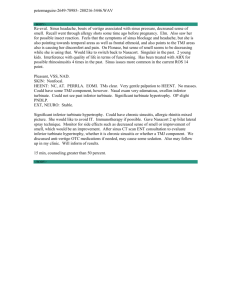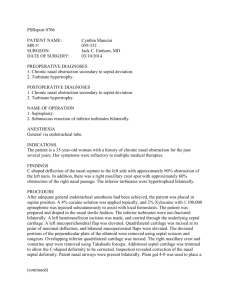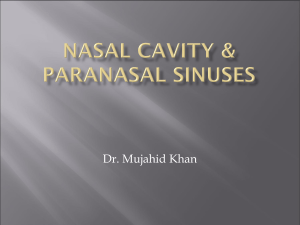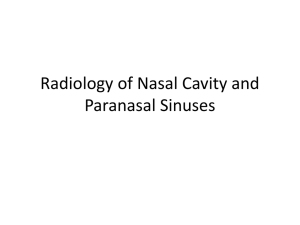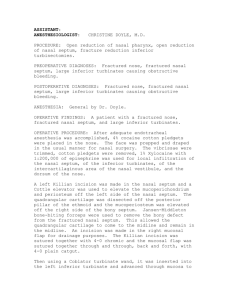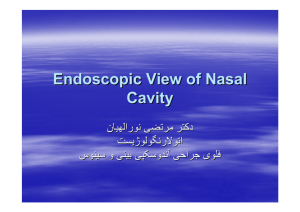External nose
advertisement
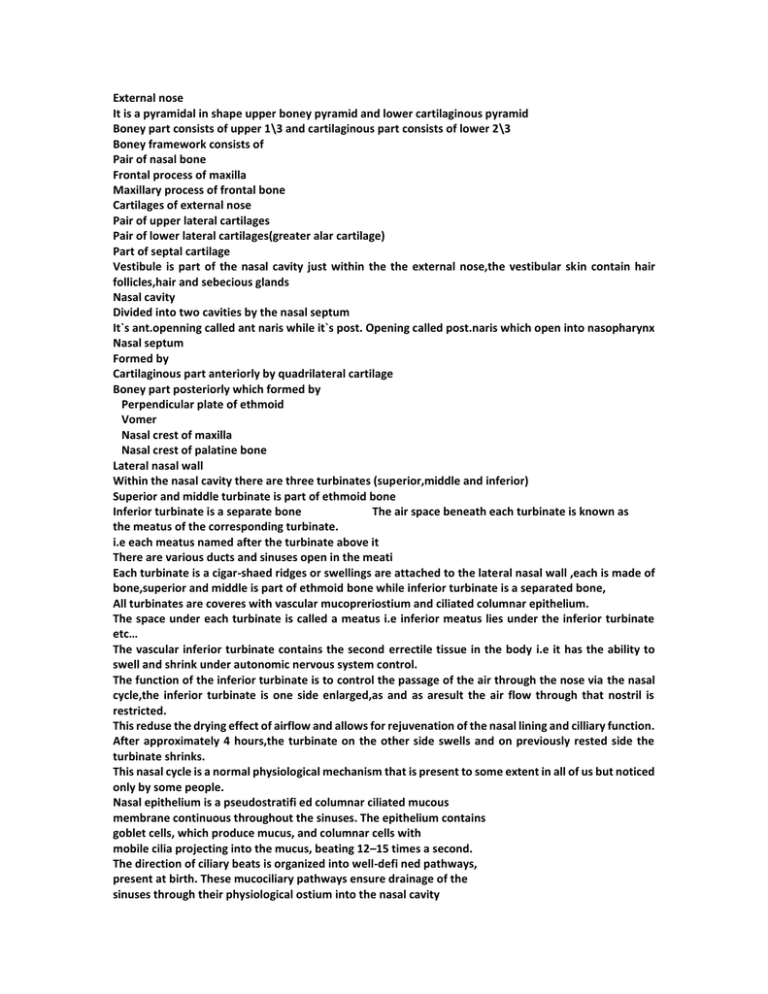
External nose It is a pyramidal in shape upper boney pyramid and lower cartilaginous pyramid Boney part consists of upper 1\3 and cartilaginous part consists of lower 2\3 Boney framework consists of Pair of nasal bone Frontal process of maxilla Maxillary process of frontal bone Cartilages of external nose Pair of upper lateral cartilages Pair of lower lateral cartilages(greater alar cartilage) Part of septal cartilage Vestibule is part of the nasal cavity just within the the external nose,the vestibular skin contain hair follicles,hair and sebecious glands Nasal cavity Divided into two cavities by the nasal septum It`s ant.openning called ant naris while it`s post. Opening called post.naris which open into nasopharynx Nasal septum Formed by Cartilaginous part anteriorly by quadrilateral cartilage Boney part posteriorly which formed by Perpendicular plate of ethmoid Vomer Nasal crest of maxilla Nasal crest of palatine bone Lateral nasal wall Within the nasal cavity there are three turbinates (superior,middle and inferior) Superior and middle turbinate is part of ethmoid bone Inferior turbinate is a separate bone The air space beneath each turbinate is known as the meatus of the corresponding turbinate. i.e each meatus named after the turbinate above it There are various ducts and sinuses open in the meati Each turbinate is a cigar-shaed ridges or swellings are attached to the lateral nasal wall ,each is made of bone,superior and middle is part of ethmoid bone while inferior turbinate is a separated bone, All turbinates are coveres with vascular mucopreriostium and ciliated columnar epithelium. The space under each turbinate is called a meatus i.e inferior meatus lies under the inferior turbinate etc… The vascular inferior turbinate contains the second errectile tissue in the body i.e it has the ability to swell and shrink under autonomic nervous system control. The function of the inferior turbinate is to control the passage of the air through the nose via the nasal cycle,the inferior turbinate is one side enlarged,as and as aresult the air flow through that nostril is restricted. This reduse the drying effect of airflow and allows for rejuvenation of the nasal lining and cilliary function. After approximately 4 hours,the turbinate on the other side swells and on previously rested side the turbinate shrinks. This nasal cycle is a normal physiological mechanism that is present to some extent in all of us but noticed only by some people. Nasal epithelium is a pseudostratifi ed columnar ciliated mucous membrane continuous throughout the sinuses. The epithelium contains goblet cells, which produce mucus, and columnar cells with mobile cilia projecting into the mucus, beating 12–15 times a second. The direction of ciliary beats is organized into well-defi ned pathways, present at birth. These mucociliary pathways ensure drainage of the sinuses through their physiological ostium into the nasal cavity المحاضره الثانيه The middle meatus is of special signifi cance as it contains the ostiomeatal complex (OMC). This is an anatomical area in the bony lateral nasal wall comprising narrow, mucosal lined channels and recesses into which the major dependent sinuses drain. The OMC acts physiologically as an antechamber for the frontal, maxillary and anterior ethmoid sinuses. Irritants and antigens are deposited there and may cause mucosal oedema. As the clefts in the OMC are narrow, small degrees of oedema may cause outfl ow tract obstruction with impaired ventilation of the major sinuses The configuration of the structure of the middle meatus are complex and variable,in disarticulated skull ,the maxillary bone has a large opening in its medial wall,the maxillary hiatus. In articulated skull this is filled by adjacent bones 1 inferior: maxillary process of inferior turbinate bone 2 posterior:perpendicular plate of palatine bone 3Anterosuperior:lacrimal bone 4superior:UP and Bulla ethmoidalis So portion of maxillary hiatus is left open these osseous attachment which in life filled wth mucous membrane of 1 Mucous membrane ofMM 2Mucous membrane of maxillary sinus 3 Intervening connective tissue and membranous portion of lateral wall It is the site for the common pathway of the anterior group of sinuses(frontal,anterior ethmoid,mawillary) structure contribute to this area: Uncinate process Thin bony structure runs anterosueriorly to psteroinferioly.it articulate with the ethmoidal process of inferior turbinate,it artly cover the oening of maxillary sinuse Hiatus similunaris It is a semilunar groove which leads anteriorly to the ethmoidal infundibulum Ethmoidal infundibulum It is a short passage at the anterior end of the hiatus Frontal sinus,maxillary and anterior ethmoid drain into it Bulla ethmoidalis It ia a round prominence formed buldging of ethmoid sinus Frontal recess Maxillary sinus Middle Meats Middle Meatus Lies lateral to the MT Structure important in the MM: UP HS BE Ethmoid infundibulum Anterior and posterior fontanelle: Are membranous areas between the interior turbinate and uncinated process,accessory ostia are found mostly in the posterior fontanelle

